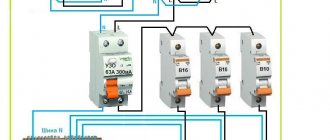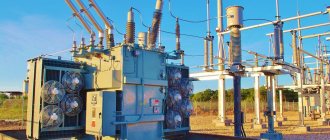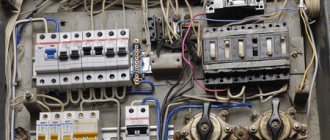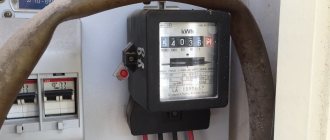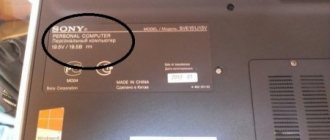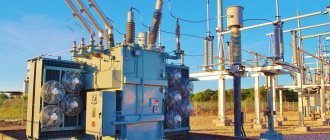What power is the socket designed for?
When choosing a socket mechanism, pay attention to the rated current at which it can be used for a long time. Its size is marked on the back of the case.
This value must not be exceeded. Otherwise, a regime will arise when the temperature heating from the passing current begins to significantly exceed the ability of the structure to remove heat to the environment. This will lead to contact burnout and may cause a fire.
Let's imagine that a tee with a connected TV, a landline phone power supply and a mobile phone charger is connected to a 6 ampere outlet, as shown in the very first photo, or a more powerful iron with 1000 watts of power.
Through the socket and the plug or tee inserted into it, load current will flow to all connected consumers.
Right on the picture is the working load calculation which will be 4.5A which is less than the rated value. This means that we have a power reserve, and the outlet is not overloaded.
However, if you power a washing vacuum cleaner with a consumption of 2000 watts from it, then the current will be 2000/220 = 9 amperes. This value is more than the socket can withstand and its mechanism will burn out.
How much load can one socket withstand?
The question of how many plugs can be plugged into one extension cord is quite confusing. After all, there are many factors on which the endurance of electrical wiring depends in each specific case. In order to determine the capabilities of one outlet, you need to understand some concepts and definitions.
Voltage
. This is a physical quantity that shows the work done to move a charge from one point in an electrical circuit to another. The unit of measurement is Volt. For our country, the accepted voltage is 220 V. This indicator must be taken into account, since it is used to calculate the load that the outlet can withstand.
Current strength
. This is the ratio of the amount of charge passing through a certain surface to the time of this passage. It is measured in Amperes. For our sockets, this value is mainly from 6.3A to 10A.
Instruments for measuring current strength
Power
. Shows the rate of conversion, consumption or transmission of electrical energy of any system. Measured in Watts. The power of electrical appliances is indicated in the technical specifications, and also, as a rule, on the housing.
The permissible load on an outlet is an indicator of the number of watts that both the outlet itself and the wiring can withstand when several devices or one powerful device are operating simultaneously.
A simple calculation with the indicators we have will look like this: to calculate the permissible number of watts, you just need to multiply the current by the voltage. For our domestic sockets, this calculation will look like this: 6.3A * 220V = 1386 W. Thus, the total power of devices that can be simultaneously connected to one outlet should not exceed 1386 W.
More information about choosing and installing a socket
If the required current in an outlet is 1 ampere, how many volts should it contain?
Ampere and volt are different physical quantities. A volt (V) is the voltage required to push 1 C (coulomb) of electricity through a network. Ampere (A) is the strength of electric current in a conductor, showing how many coulombs pass through the conductor in 1 second. If the current in a conductor is 1 Ampere, this means that in 1 second it passes a charge of electricity equal to 1 C.
If the current strength is multiplied by the network voltage, then in the end we get an indicator of its power. For example:
Normal household voltage - 220 V
Electrical power = 220 V*1 A = 220 W (Watt)
Therefore, the question of how many volts are in an ampere does not sound entirely correct. The correct wording is: “What power (in watts) does an electrical appliance develop that consumes a current of 1A?”
The answer to it will sound like this: “An electrical device that consumes a current of 1A, when connected to a household power supply with a voltage of 220V, will develop a power of 220 W.”
Formulas for calculating the current and power of the power line are presented in the figure below.
How to choose an outlet for your home?
A socket is a device for connecting household appliances to the electrical network. It consists of a housing and a block, to the contacts and terminals of which the current-carrying wires are connected.
There are household and industrial sockets. According to the standards, the average voltage is 220V in a household outlet. The permissible current for such an outlet is 10A-16A, which is suitable for connecting a device with a power of 3520 W. When installing equipment with higher power, the contacts become very hot, and the possibility of fire increases. For an 8 kW electric stove, a regular outlet that can withstand a current of 16 A will not work.
How to find out how many amps there are in a 220-volt outlet? If we divide 8 kW (8000W) by the network voltage (220V), we find that the current strength when connecting such a stove will be over 36A. This means that the characteristics of the outlet must indicate that it is designed for a current of up to 40A. Similarly, you can select sockets for other household appliances.
How to independently measure the current in an outlet?
The current strength in a 220V socket is not measured, since it is not there. An outlet can only be designed for a certain current strength, which is necessary for the operation of a particular device.
The current strength in a certain section of the circuit is checked. An ammeter is used for this purpose. The current is measured in the following sequence:
- It is necessary to create a series circuit consisting of a household appliance, the current of which needs to be measured, and an ammeter.
- When connecting the ammeter, the polarity must be observed - the “+” of the measuring device is connected to the “+” of the current source, and the “-” to the “-” of the current source.
The ammeter on the electrical circuit for measuring direct current is indicated by the symbol:
As is known, there is a dependence of the current on the voltage in the network. To measure it, Ohm's law is used: I (current strength in a section of the circuit) = U (voltage in this section) / R (constant indicator of the resistance of the section).
How and with what to measure the voltage in an outlet?
The voltage in the home electrical network should be within 220V ±10. The maximum voltage in the network should be no more than 220+10%= 242V. If the apartment is dim, or the light bulbs burn too brightly, or burn out quickly, or electrical appliances often break down, we recommend checking the voltage in the outlet. For this purpose special devices are used:
Before using the device, its insulation must be checked.
How to check the voltage in an outlet? To do this, set the measurement limit switch to the required position (up to 250 V - for measuring alternating voltage).
The probes of the device are inserted into the sockets of the socket, the device display will show the voltage in the socket.
Attention: do not touch live wires and contacts with your hands.
How to properly connect a three-phase outlet?
When installing a 380 volt outlet, 4 or 5 wires must be connected correctly. If you mix up zero and phase, this can lead not only to damage to the electrical appliance, but also to a fire in the wiring.
The power line for powering the device consists of a three-phase socket and its corresponding plug. The 380 volt outlet is connected in the following sequence:
In what case is a three-phase socket installed?
Most electrical appliances used in the home are designed for standard mains voltage (220V). But there are appliances, electric stoves, production equipment, powerful pumps that are designed for a higher voltage of 380 V. Three-phase sockets are installed for such equipment.
A three-phase socket has four contacts - three of them (L1, L2 and L3) are used to connect the plug, and the fourth (N) is neutral, which is used as grounding.
To connect a 380V socket, a four-core cable (3 phases + zero) is laid from the panel. The minimum cut area of the conductor is 2.5 mm2. The best option for connecting powerful machines is a 3x4+2.5 copper wire (consisting of three wires with a cross-section of 4 mm2 and one wire with a cross-section of 2.5 mm2).
How many amperes are in a 220V outlet?
To find out how many amperes are in a regular 220V home socket, first of all, remember that current is measured in Amperes :
Current strength “ I ” is a physical quantity that is equal to the ratio of the charge “q” passing through the conductor to the time (t) during which it flowed.
The main thing that is important to us in this definition is that current strength occurs only when electricity passes through a conductor, and while nothing is connected to the outlet and the electrical circuit is broken, there is no movement of electrons, and accordingly there are no amperes in such an outlet either.
In an outlet to which there is no load connected, there are no amperes, the current strength is zero.
| In our age of dizzying technologies, in every home there are a dozen, or even two, electrified household appliances. Washing machines and refrigerators, food processors and stereo systems, computers and televisions. The list of things needed in the house, produced by enterprises and powered by an electrical network, can consist of several hundred items. True, some small-sized radio electronics devices can be powered by dry batteries or batteries. But batteries also require periodic recharging using an AC charger. Considering the above, every modern person should have the minimum necessary knowledge in electrical engineering in order to properly connect household appliances. This question is not idle, since incorrect connection can lead to damage to electrical wiring, plugs, sockets, adapters, extension cords and even lead to a fire. Judge for yourself: if a load consuming a current of 10 A is connected to a socket designed for a current of up to 6 A (6 amperes), the contact points will begin to get very hot. In this case, the plastic parts will begin to melt and emit an unpleasant odor. In addition, combustion products are extremely harmful to humans. In the future, sparking may appear in the outlet, and the device itself may fail. Possibilities of the household electrical networkTo avoid disaster, you need to know the capabilities of your home electrical network and keep its components in order. It must be remembered that if the apartment has sockets from the Soviet period, they are usually designed for a maximum load of 6 A. Modern European-type sockets are available in two versions - for a current of up to 10 A and for a current of up to 16 A. It often happens that old Soviet sockets are replaced with sockets of the European standard. This is permissible if the cross-section of the wires is capable of withstanding the specified current. Otherwise, with high current, the apartment wiring may heat up. Unclear questions will be successfully resolved by the on-duty electrician of the housing and communal services. What are the electrical loads?The power supply of household electrical appliances is characterized by the type of current, rated voltage, power consumption or current consumption. The type of current is alternating, with a frequency of 50 Hz (50 hertz). The voltage is 220 V (220 volts). Power consumption depends on the specific household device, is indicated in the passport and marked on the device body. Electrical network parameters may vary in different countries of the world. For example, in Japan, a household network with a voltage of 100 V is used. Therefore, Japanese household appliances, designed to work in their native country, will not work in Russia and, most likely, will burn out from overvoltage. Of course, Japanese manufacturers export devices adapted accordingly, but there are cases when “pure Japanese” end up in Russia. In this case, the device should be connected via a special 100 V / 220 V adapter - a step-up transformer. Any electrical device consumes a certain amount of power from the network. Power consumption is an important parameter; it should be of interest to the consumer, first of all. Data on power consumption can be found on the device body or in the technical documentation - manual, passport, operating instructions. It is important to be able to distinguish powerful loads from weak ones. Powerful loads should be considered products with a power consumption of more than 100 W (100 watts). Accordingly, electrical appliances up to 100 W can be classified as low-current. Particular attention should be paid to powerful household appliances, since it is when they are connected that errors occur. How are power consumption and current related?These parameters are connected by a simple formula: power is the product of current and voltage. This formula makes it easy to calculate the permissible power in watts for outlets that have a maximum load current in amperes. With a network voltage of 220 V, we calculate the maximum power values for 6 A, 10 A and 16 A sockets. Multiplying the voltage by the corresponding current, we obtain the following power values:
Knowing these values, as well as the passport data of power consumption for the household electrical appliances used, you can resolve all issues related to connecting appliances in the house. |
How to choose electrical wiring
Let us pay attention to this issue because current-carrying conductors must reliably transmit the electrical power applied to them, creating heating of the metal and its insulation no higher than the permissible temperature. Otherwise, the dielectric layer will be damaged and leakage currents will flow through it.
Then the potential of the phase can at any time appear on the housing of household appliances or metal building elements, which will lead to electrical injuries to residents. The only way to prevent them is to use an RCD. And if it is not there, as usually happens, then trouble is guaranteed.
We remind you that in places where wires are poorly connected and electrical contacts are broken, the temperature increases abruptly. It can cause a fire.
Wires in old buildings
The principle of providing the population with electricity in Soviet times was solved through the creation of several standard projects for laying wiring in apartments. At that time, this was the best option for solving the problems of state building.
The wires, taking into account the low loads by today's standards, were made of 2.5 sq mm aluminum wire. There was a 5 amp meter at the entrance to the apartment, and there were two outlets in each room. Their power reserve was sufficient.
Now the power of household appliances, and their number in each family, has increased sharply. But people still live with old wiring and use tees and extension cords, which can lead to dire consequences.
Modern loads can create emergency situations in old aluminum wiring, which is rated for a maximum of 20 amperes.
Modern wiring
Aluminum wires and cables for installation in residential premises are already prohibited by current rules. In old buildings, some residents replace them with their own hands, while others continue to exploit them, hoping for a Russian “maybe.”
To connect sockets, use only copper wires and cables with a core cross-section of 6, 4 or 2.5 sq. mm. It should be taken into account that they can withstand a current averaged for different operating conditions of 27 A for 2.5 square meters, 38 for 4 and 46 amperes for 6 mm square. There is no point in considering large loads.
What cross section should the cable be?
For most electrical appliances, a copper cable with a cross-section of 2.5 mm2 is sufficient. This cable can withstand loads of up to 3.5 kW (16 A). If the load is higher, the cross-section must be larger.
Some rooms require thicker cables. For example, if an electric stove and (or) oven are connected in the kitchen, it is necessary to use wires with a cross-section of at least 4 mm2, and preferably 6 mm2. Electric water heaters and other high-wattage appliances also require thick wires.
For lighting it is recommended to use a cable with a cross section of 1.5 mm2. If low-power lighting devices are used, for example, LED lamps, you can also lay a wire with a cross-section of 0.75 mm2. However, such cables cannot be used for sockets to which various electrical appliances are connected.
How automatic protections ensure electrical safety
We have analyzed the normal power modes of household appliances according to the loads they create on wiring and sockets. These currents must be reliably transmitted from the power source to the consumer.
Now let’s assume that a water hose bursts inside the washing machine, and the phase and zero potentials are closed in the wet area. Or, for example, an inexperienced home craftsman drilled into a live cable.
In both cases, a short circuit current will immediately occur, which is accompanied by an electric arc. Its power not only burns the insulation, but also melts the wiring, spraying the liquid copper metal with sparks in all directions.
To prevent the development of a fire, circuit breakers are used, which completely remove the voltage from the equipment they protect in a split second. They must be selected correctly based on many parameters.
This issue is presented in a separate article about the design of the circuit breaker and the principles of its operation. We recommend you read it. Pay special attention to checking the phase-zero loop. Few people still do it. And this is very important.
What's the best thing to do?
Why is it necessary to connect several electrical appliances to one outlet? Because the entire wiring system is not designed correctly. Weak cables, insufficient number of power sockets.
There are several ways to correct the situation:
1. The best and easiest way is to apply to change a single-phase input to a three-phase one. After this, invite a professional electrician and ask him to change the wiring throughout the apartment.
2. You can change the wiring in the apartment yourself, if you take into account the basic rules:
- choose the right brand of cables, excluding aluminum ones;
- select their cross-section in accordance with the maximum load that you plan to supply;
- it is reasonable to choose a protection system (so as not to run to traffic jams every 5 minutes, but in strict accordance with the power of the selected cables);
- exclude the possibility of the cable passing through flammable structures;
- pack all connections in distribution boxes;
3. Follow basic safety rules, not leaving electrical appliances on, regularly checking the condition of connections in junction boxes, the condition of sockets and switches (including changing them in a timely manner if there is doubt about their condition), maintaining a reasonable load on the wiring and each socket separately, turning off the input bag for a long absence from the house. Then the system will work properly and you can use it comfortably.
The importance of electricity is difficult to overestimate, but human safety, and especially life, are much more expensive. That is why you should not skimp on the services of experienced craftsmen by trying to do everything yourself.
It is better to independently monitor preventive maintenance and follow basic safety rules. As for active actions with wiring and input, if you have the slightest doubt, you should contact experienced specialists.
